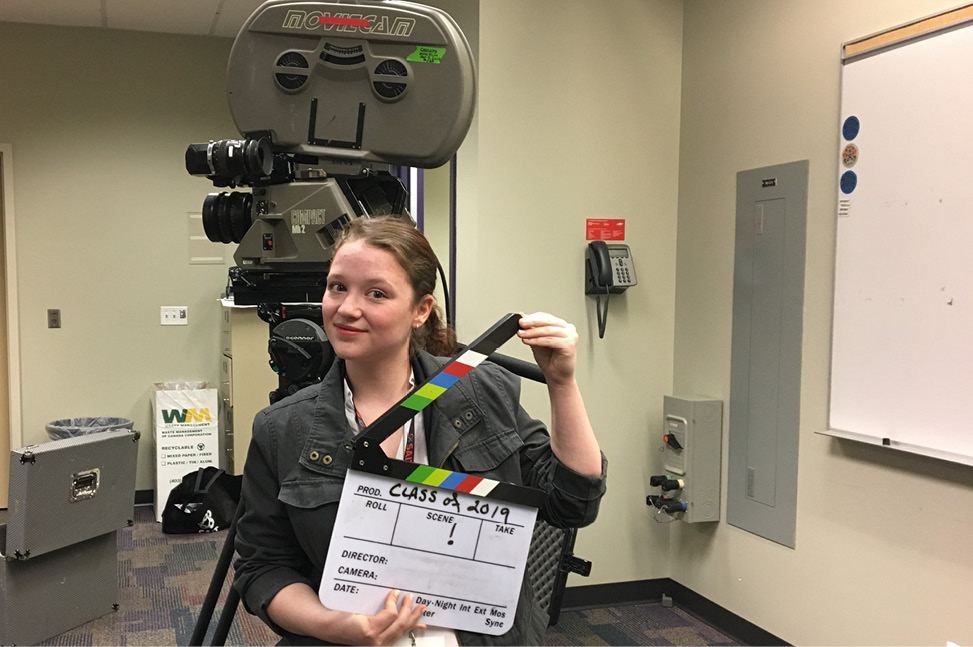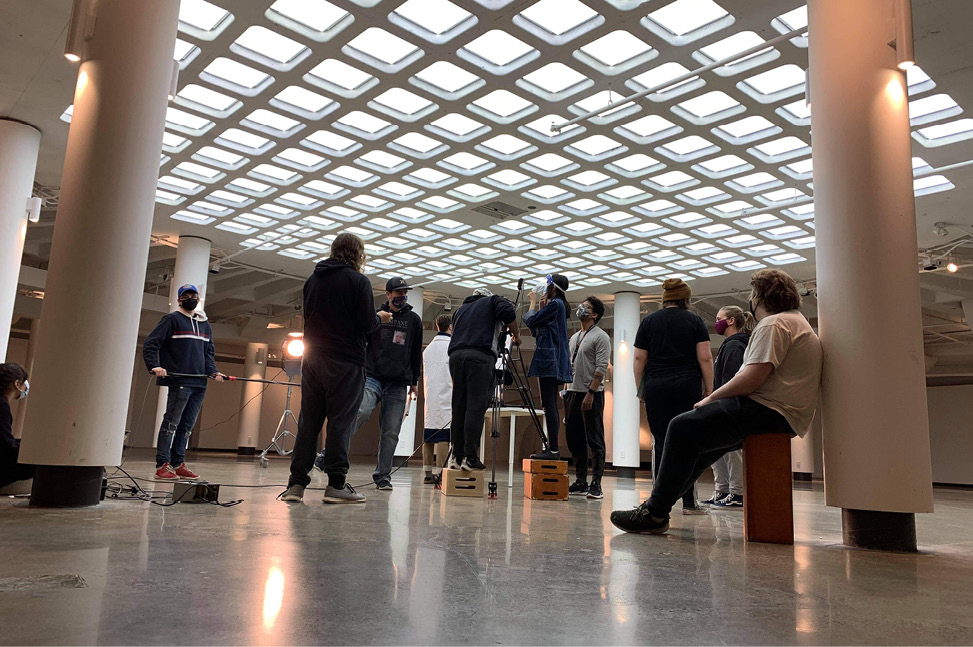Alberta is the new Hollywood and SAIT is on set

Lights, camera, action, and Calgary is now American Fork, Utah.
Watch Under the Banner of Heaven closely, and you still won’t see SAIT alumna Umesh Thamotharam (FVP ’21) lurking in the background. He’ll have to tell you where he was hiding.

As a P.A., Thamotharam would be tasked with a variety of things to get the set ready for the shoot. At times he held traffic to prevent cars from inadvertently driving into the scene. When filming at one location ended, his team cleaned up until the space was pristine, not a trace of the crew’s presence left behind.
Carver Skahl (FVP ’21) and Katelynn Janes (FVP ’21) can also say working on the COVID Health and Safety team kept all actors — including Andrew Garfield and Daisy Edgar-Jones — healthy and upbeat while the show was filmed. In turn, the opportunity to work on the team provided the SAIT alumni with a peek into all departments involved in the making of the show. When the hustle and bustle calmed, they could chat with the camera, lighting and special effects departments. Their team engaged with everyone to keep them masked up and socially distanced.
“Essentially, we were in charge of making sure everyone followed the guidelines to keep their mask on,” says Janes.
“We also helped people get tested, every Monday, Wednesday and Friday.”
Under the Banner of Heaven is one of a couple of big television productions shot in Alberta recently. The series is about the investigation of a brutal murder in a Mormon community. When Andrew Garfield learned he’d be the main character for the series adaptation, he took the role seriously.
“He’s very determined in what he does. He cares about his performance,” says Skahl, who met Garfield on set.
Be warned: the show is quite dark, says Skahl.
Community and Connections
The SAIT Film and Video Production diploma prepared Thamotharam, Skahl, and Janes for the reality of the film industry, and provided the connections to step on set.
Working professionals in the industry are brought in as guest speakers during the program, providing students with networking opportunities. The practicum portion of the program and support from instructors also provided opportunities for students to find work.
A friend and fellow SAIT alum’s post about potential work on a production in a group chat led to Skahl and Janes finding their place on the COVID Health and Safety team.
“Connections are everything,” says Janes. “If you know someone and they know your work, they will spread your name around and you’ll get more work.”
Not only were the SAIT alumni in close proximity to big screen names, but they also rubbed (physically distanced) shoulders with former program peers.
“I think the coolest thing about working on it was getting to see people that I went to school with on set. Because we all kind of dreamt of that moment,” says Skahl, who has loved films since he was little. Skahl’s own favourite film genre is horror and he would love to write a feature in that genre someday.
Thamotharam, on his part, liked working towards the same objective.
“Overall, I just really enjoyed working with a group of people that have the same goal, which is to help make something look really good,” he says.
From video game to HBO show
Next year, when The Last of Us is released, Jessica Rovansek (FVP ’19) will be able to say she enjoyed playing the video games and she worked on the HBO show too.
The Last of Us is set to release in early 2023 and will feature actors Pedro Pascal, Bella Ramsey and Gabriel Luna. The screenplay was adapted from the video games and is focused on Joel and Ellie, a pair connected in a post-apocalyptic environment — if you’ve played the game, you likely have an idea already.
When the opportunity to work on the series presented itself to Rovansek, it was an easy yes.
“I couldn’t pass up the opportunity. I mean, it’s The Last of Us, it’s HBO,” she says. “You play the game, you understand the story, but to see it come to life on a screen, with real people is kind of amazing.”
Rovansek worked on the dailies. Every day, she would receive the camera cards where the footage was stored. She properly labelled the files with relevant metadata and uploaded them to long-term storage for proper safeguarding, which is called a Linear Tape Open (LTO). With a slight colour touch up and export, she would then send the dailies to the editors.
Every company likes to do things differently, as Rovansek explained. For her work on The Last of Us, it meant understanding how editing suites were set up, dailies processed and naming conventions applied. Before the show, she had never set up an LTO before.
Thamotharam also worked on The Last of Us, as a visual effects (VFX) production assistant (P.A.). He captured photos of the same locations but at different times of the day. Having the same spot in different exposures provides context to create the most realistic visual effects possible.
Spotlight on Alberta
It’s an exciting time to work in film in Alberta.
“We have a really good stake in the film industry, our locations being one them,” says Rovansek, who also maintains the province has the best crews in Canada.
Alberta has peaks, valleys, badlands and cities. In other words, countless landscapes for stunning backdrops. New funding and incentives, tax credits and the elimination of per-production caps in the province are designed to bring in creative industries and create job opportunities.
“It’s very good to hear that film is coming somewhere close to me or people like me,” says Skahl. “I’m really thankful for all of the instructors over at SAIT for preparing us for that world, and that day-to-day life.”
Thamotharam echoes Carver’s sentiment: “Excellent experience there and I’ll always forever be grateful for the instructors.”
Janes recommends anyone considering taking the program to go for it, with the following piece of wisdom: keep in touch with your peers, because the next gig might pop up in your group chat.
“Don’t be afraid to try, even if it’s out of your comfort zone!” she says.
Get in on the action
The Film and Video Production program is expanding to support the talent shortage. In 2018, the program took in 30 students. This Fall, over 150 students will be in their first year, and a new Spring/Summer intake will allow students to complete the full diploma in 15 months.
“I feel like if I didn’t have the guys at SAIT, and the instructors at SAIT, I don’t think I would have been as prepared as I was,” says Carver.
SAIT’s Film and Video Production Program covers all you need to know on the technical side, from cameras to grip equipment, set-up, function and takedown.
But that’s not all.
“One of the best things about SAIT is they not only teach you those, but they also teach you how to work with other people, and other people’s interests,” says Thamotharam.
The learning doesn’t stop after leaving SAIT’s classroom, but the Film and Video Production program makes sure students are well-positioned to succeed.
Skills for the Future
We prepare students for successful careers and lives.
SAIT'S
2020-2025
Strategic plan

Oki, Âba wathtech, Danit'ada, Tawnshi, Hello.
SAIT is located on the traditional territories of the Niitsitapi (Blackfoot) and the people of Treaty 7 which includes the Siksika, the Piikani, the Kainai, the Tsuut’ina and the Îyârhe Nakoda of Bearspaw, Chiniki and Goodstoney.
We are situated in an area the Blackfoot tribes traditionally called Moh’kinsstis, where the Bow River meets the Elbow River. We now call it the city of Calgary, which is also home to the Métis Nation of Alberta.